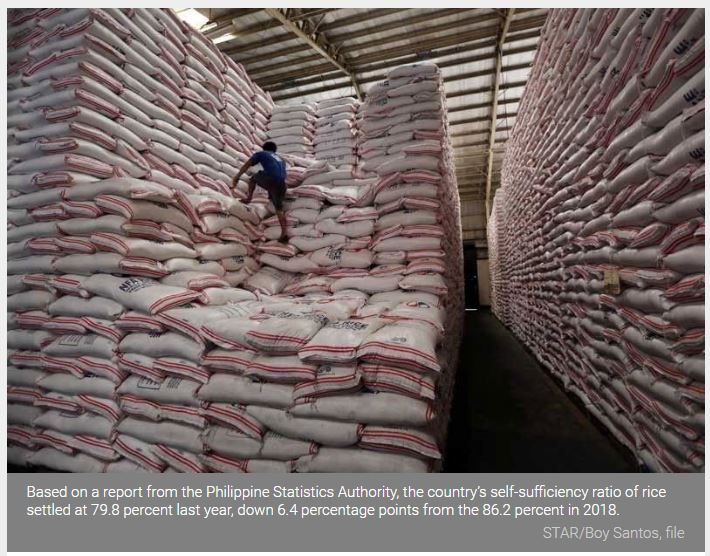Philippine rice self-sufficiency dips in 2019
MANILA, Philippines — The Philippines continues to fail in producing enough food for the growing population as the country’s rice self-sufficiency has declined to 79.8 percent in 2019, resulting in higher import dependency for Filipinos’ main staple.
Based on a report from the Philippine Statistics Authority (PSA), the country’s self-sufficiency ratio (SSR) of rice settled at 79.8 percent last year, down 6.4 percentage points from the 86.2 percent in 2018.
The SSR shows the magnitude of production in relation to domestic utilization and the extent to which a country’s supply of commodities is derived from its own domestic production.
A ratio of less than 100 percent indicates inadequacy of food production to cope with the demand of the population.
In turn, the country’s import dependency ratio (IDR) of rice increased to 20.2 percent from 13.83 percent in 2018.
Agriculture Secretary William Dar said the lower SSR is mainly due to the initial implementation of the Rice Tariffication Law, which opened the floodgates for more cheap imports.
“It was the shock of the RTL. Around 50,000 hectares of previous rice lands were not planted to rice but other commodities. It is bad because the total rice yield was low,” Dar told The STAR .
“But it is also good because it starts the restructuring of the rice sector where marginal uncompetitive rice lands shift to cultivation of other crops,” he said.
For this year, the DA is targeting an SSR of up to 93 percent.
For the Federation of Free Farmers, the decline in SSR is not surprising, considering that 2019 was marked by a drought during the first semester.
“The drop in palay (unhusked rice)prices following RTL could have also affected farmers’ decision to plant and invest in their farms, and this will be reflected in planted or harvested areas and to some extent yields due to lower usage of inputs,” FFF national manager Raul Montemayor told The STAR.
“Definitely, one big reason for the drop was the increase in imports coupled with the relative decline in production, resulting in a drop in the SSR,” he said.
On the other hand, corn, which is the country’s second major crop, registered an improvement in SSR to 94.6 percent in 2019 as compared with the 2018 ratio of 88.4 percent amid increasing local production. Its importation went down to 5.4 percent.
Further, adequacy in production was continuously reported for coconut and sugarcane, as well as for fruits like calamansi, papaya and pomelo.
Vegetables and root crops such as tomato, cabbage, eggplant, cassava and sweet potato also maintained adequacies in production.
The domestic production levels of garlic, peanut and mongo remained deficit with their respective SSRs recorded at 7.9 percent, 25 percent and 50 percent.
For livestock and poultry products, self-sufficiency was sustained for chevon (goat meat), chicken egg and duck egg. Moreover, the country was nearly self-sufficient for dressed duck at a ratio of 99.5 percent.
Increased SSRs were observed for carabeef at 71.7 percent, pork at 87.1 percent and dressed chicken at 94.1 percent.
Adequacy in production was still maintained for fishery products such as milkfish, shrimps and prawns, and oyster. The 2019 SSRs of roundscad and tuna went down to 78.1 percent and 76.5 percent, respectively.
Source: https://www.philstar.com/business/2020/11/02/2053917/philippine-rice-self-sufficiency-dips-2019


 English
English




